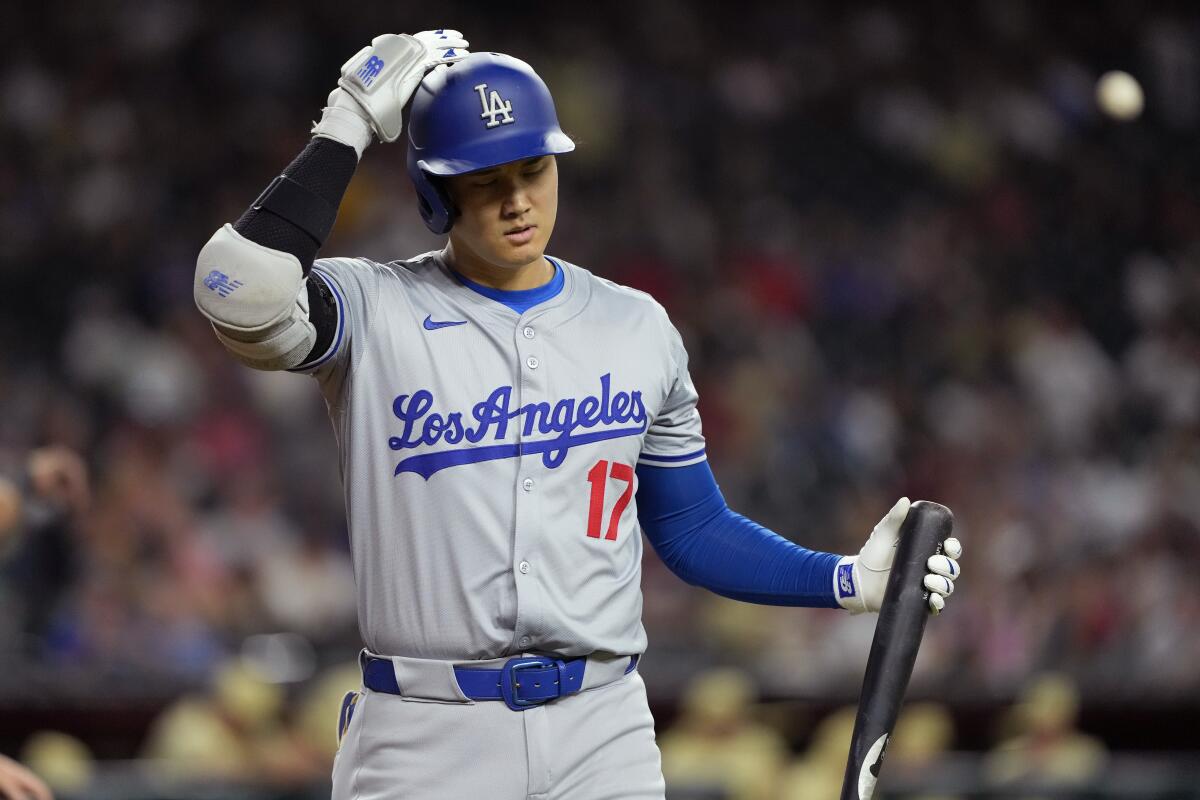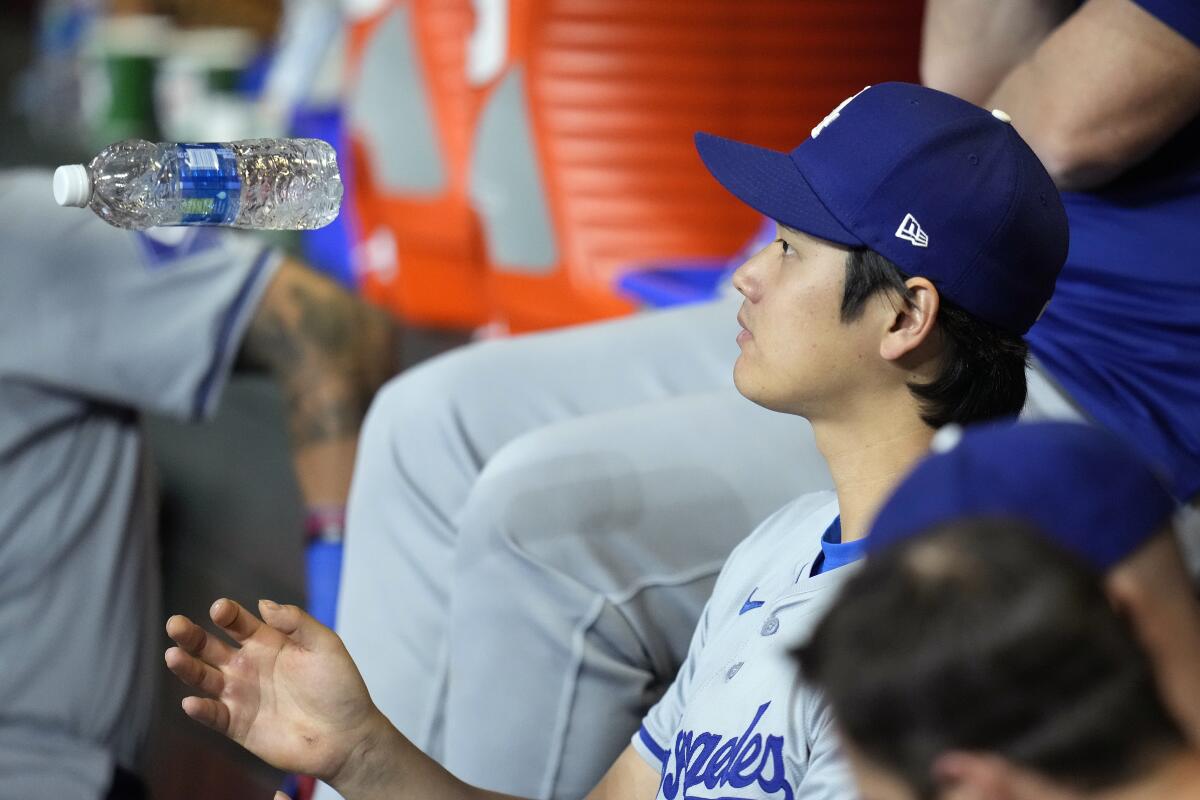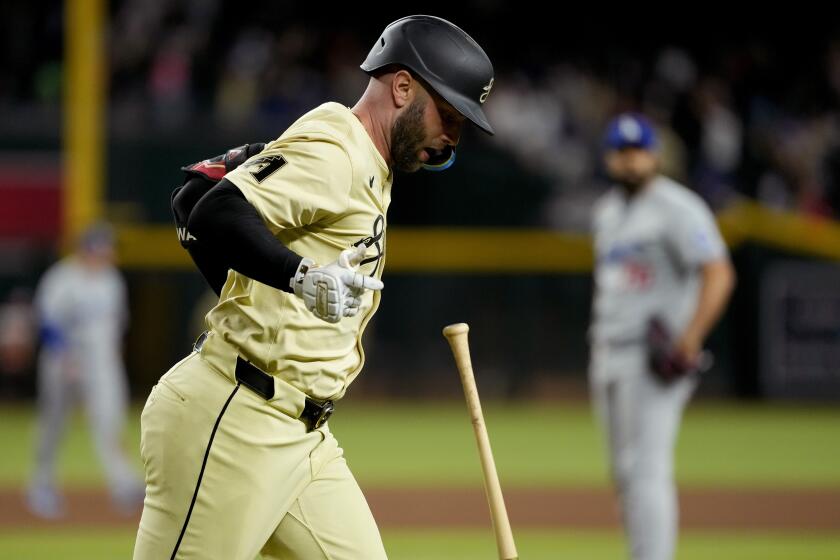How hitting with runners in scoring position has been Shohei Ohtani’s one Dodgers flaw

- Share via
The timing was coincidental.
But, on Shohei Ohtani’s first off day as a Dodger, the discourse Wednesday centered on the one big struggle of his 2024 season — a weakness that had cropped up again the night before.
When there hasn’t been a runner at second or third base this season, Ohtani has been the best hitter in baseball. He is batting an MLB-best .398 in such spots. His .774 slugging percentage is more than 100 points better than all but two other players.
When the Dodgers need to start a rally, the $700-million signing is often their most potent spark.
However, with runners in scoring position over the first month of the season, the slugger’s production has unexpectedly cratered, leading to a trend of frustratingly empty key at-bats.

With RISP, Ohtani is batting just .184 (seven for 38) with a .237 slugging percentage. Of the 14 big leaguers with at least 35 such at-bats, he is the only one with fewer than 10 RBIs. And, somewhat amazingly, he has driven in more runs without RISP (10, including all seven of his home runs) than with RISP (nine).
The two latest examples came in a Tuesday loss to the Arizona Diamondbacks, when Ohtani struck out in the fifth inning with runners on second and third, then almost hit into an inning-ending double-play in the top of the 10th, having to use his speed to beat a throw to first and prolong the inning — one that still resulted in only one Dodgers run, before the Diamondbacks scored twice in the bottom half for a walk-off win.
“Certainly, there was some opportunities,” manager Dave Roberts said a day later, after — in what he insisted was an unrelated decision — deciding to give Ohtani his first day off. “But, I don’t want to say [it was him taking a] step back.”
Maybe in the context of this season, it wasn’t.
But, compared to his last three seasons with the Angels, when producing in situational at-bats was one of the two-time most valuable player’s signature strengths, Ohtani’s struggles this season have thus far been confounding.
From 2021 to 2023, Ohtani was one of Major League Baseball’s best hitters with RISP. He batted .305 in those situations, the 22nd-best mark in the majors in that span. He slugged .689, easily the best mark among big league hitters.
On the surface, the explanations for this season’s regression seem simple.
Compared to his non-RISP at-bats, Ohtani swings more frequently (56% with RISP, 43% without) and chases more often (31.5% with RISP, 26.5% without) with a chance to drive in runs.
It has led to shorter at-bats (he sees 3.5 pitchers per plate appearance with RISP, and 4.2 without) and, despite a decrease in strikeouts, an also slightly lower walk rate (9.1% with RISP, 10.5% without).
Whenever he does come up empty on a pitch outside the strike zone, it’s easy for fans and media members to identify in real time.
“Shohei is as aggressive as those bees were,” Roberts said, jokingly referring to the swarm of bees that delayed Tuesday’s game. “Hitters [like him] want to hit. … They want to hit in big spots.”

It’s just that, this season, he almost seemed to want to do so too badly too many times.
There is an important caveat to all this, though: Ohtani’s approach with RISP this season hasn’t seemed to differ much from what he did in Anaheim.
From 2021 to 2023, Ohtani swung with RISP almost 53% of the time, only slightly less than this season. He would chase pitches at a 35% rate, slightly more often than the opening month of this season.
Such aggression is evidently by design. When asked about his RISP approach a couple of weeks ago, Ohtani acknowledged through his interpreter that “the zone that I am swinging in is a little bit larger with runners in scoring position.”
Opponents, after all, are more likely to pitch around him with RISP. If he wants to “move the ball forward,” as Roberts likes to say, it requires hitting pitches not directly over the heart of the plate.
“Certainly,” Roberts said, “he feels like he’s the best option to drive in a run.”
Of course, as the manager conceded, that does give pitchers a way to exploit Ohtani, tempting him with offerings out of the zone that he sometimes shouldn’t be chasing.
Yet, at the same time, Roberts said, “I think his DNA … is to want to swing the bat.” Which, in the manager’s opinion, “is still a good thing.”
So how does Ohtani get better with runners in scoring position?
Given his track record, the answer might not be as obvious as being more selective with his approach at the plate.
The Dodgers are nowhere near having their full complement of relievers. At least in the near future, situations similar to Tuesday might not be all that rare.
Sure, Roberts said, Ohtani needs to keep improving his plate discipline — a trait he has highlighted as a key to the slugger’s strong start to the year overall.
But just as important is for Ohtani to simply execute better when swinging outside the zone, and replicate the productive aggressiveness he honed in years past.
That could mean more consistency with his mechanics. It could mean trying to hit the ball the other way more often, something he has not done nearly as much with RISP this year compared to the past.
Whatever the case, his approach in clutch moments will continue to attract scrutiny — serving as the one place this season to poke holes in his game.
“I did see some more expanding than he has done in let’s say the last, seven to 10 games,” Roberts said of an ever-evolving process. “But I think in general, he’s been in a good spot.”
More to Read
Are you a true-blue fan?
Get our Dodgers Dugout newsletter for insights, news and much more.
You may occasionally receive promotional content from the Los Angeles Times.









